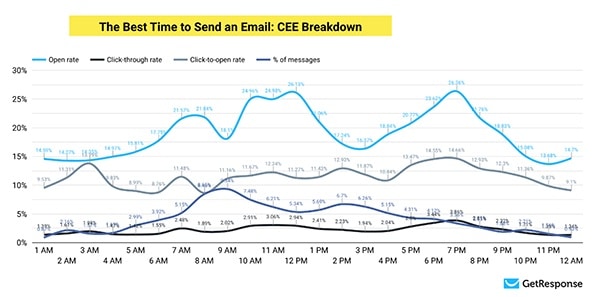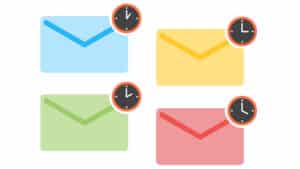EMAIL MARKETING
What Is The Best Time To Send Email by Location?
If you’re an email marketer, I bet you’ve asked yourself this question at some point – what is the best time to send email?
GetResponse has analyzed over 2.85 million emails sent within the first two quarters of 2020 and what makes this study unique is that we also divided the results by our customers’ location.
In the analysis, we only included SMB customers and tracked campaigns that went out to at least 1,000 contacts.
We looked at what time and day customers sent their email campaigns and what open, click-through, and click-to-open rates they generated.
What makes this study unique is that we also divided the results by our customers’ location.
Thanks to this, on top of seeing the global results, you’ll also be able to review the data individually for the following regions: US & Canada, DACH, EMEA, Asia-Pacific, CEE, and LATAM.
When To Use This Data?
We could argue that the best time to send an email doesn’t even exist. Or perhaps it does, but it’s not something that’s shared among a larger group of subscribers. It’s largely an individual thing.
While this may be right, there are times when we’ve got no other option but to schedule our email campaigns by hand.
Here are some scenarios when that’s often the case:
You want everyone in your audience to receive your message at the same time. For example, when running a 24-hour flash sale campaign.
Your email list is new, and you don’t have enough data to feed the algorithm.
You prefer to send your campaigns at a specific time and want your audience to form a habit of opening their inbox at a particular hour.
You have to time your campaigns according to external events, e.g. stock market trading hours.
So, if you have to select the best time to send your emails by yourself, this data will prove useful.
And is it even worth the hassle?
Just consider the numbers: Even if you can increase your email click-through rates by 0.5 percentage points (from 2% to 2.5%), it could translate into a 25% growth in sales revenue from that one campaign. For most businesses, that means a massive difference.
Just keep in mind that every audience is different. So, compare these results with what you’ve been experiencing or what your gut feeling keeps telling you. Use it as a starting point for more complex tests that you’ll do on your target audience.
Read more here.
[optin-monster slug=”em8z7q6hga9elmy1dbgb”]






